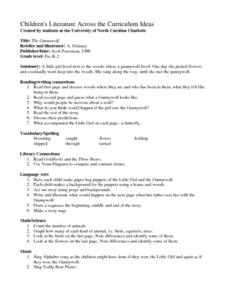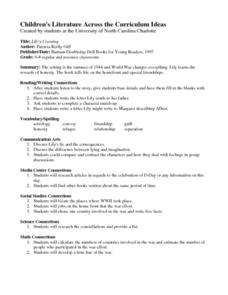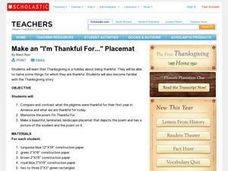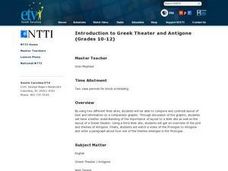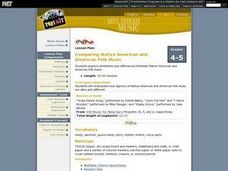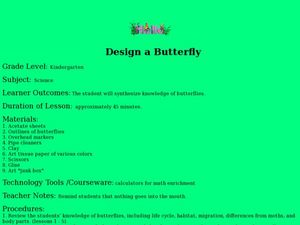Curated OER
The Gummywolf
Learners read a story about "Gummywolf," stopping periodically to answer questions about the progression of the story. Next, they create a Venn Diagram to compare and contrast "Gummywolf" to "Goldilocks and the Three Bears." Students...
Curated OER
Lily's Crossing
Young scholars listen to a story, "Lily's Crossing," about life during a World War. After completing worksheets, they compare and contrast characters in the story. Using math skills, students develop a time line of the war, calculate the...
Curated OER
Sounds of the Season
During Christmas time, use common carols and Tchaikovsky's Nutcracker music as the basis for writing advertisements. Learners can work in teams or individually as they listen to songs via the links provided. A "Christmas Music Comparison...
Curated OER
"I'm Thankful For..." Placemat
Pupils discover the story behind Thanksgiving through comparing and contrasting what pilgrims were thankful for, memorizing Thanksgiving poems, and creating a placemat that depicts the poem.
Curated OER
Social Pyramid of Ancient Egypt
Sixth graders describe the defining characteristics of major world civilizations from political, social, and economic perspectives. They compare and contrast the religions in terms of leaders, beliefs and locations.
Curated OER
Let's Get Along
Learners examine the book Smoky Night. In this cultural lesson, students read the text and discuss why it's important to get along with others. Learners complete a Venn diagram to compare and contrast themselves with a peer.
Curated OER
A Creative Presentation
Bring writing to life with this lesson in which elementary and middle schoolers create a display of the imagery they identify in a series of Gary Paulsen books. They read the suggested materials, identify imagery and descriptive...
Curated OER
Introduction to Greek Theatre and Antigone
Young scholars compare and contrast a website layout and the layout of a Greek theatre. In this Greek theatre lesson, students research the Greek theatre and produce a bulleted list of five facts about the Greek theatre. Young scholars...
Curated OER
Narrative Writing
Students create new sentences using adverb clauses identified from a book. In this narrative writing lesson, students write new sentences from some of the dependent clauses used in a book read to them by the teacher. Students...
Curated OER
Amelia Earhart - Drawing Conclusions
Examine the life of Amelia Earhart with kids. They will read facts and view a timeline about Earhart's life. They will work in groups to read the last radio transmissions and draw conclusions about what happened in her disappearance and...
Curated OER
Good Book, Bad Book: Lesson 2
An interesting way to incorporate pop culture and the elements that make a book good. Kids watch a clip from MTV Cribs, they discuss how good or bad books are similar to good or bad homes. They are all different and not everybody will...
Curated OER
Paragraph Development Exercise: Comparison
Teach class members how to use comparison in their writing to clarify and enrich ideas. Referring back to the brief description and the sample paragraph, writers develop a paragraph that uses comparison effectively. More scaffolding and...
Curated OER
Mini Beasts and Dialect
Discover the differences in dialect. Inquisitive minds read poems and discuss how words or phrases are different in standard English and other dialects. Using a dictionary, class members locate the definition of each word, find...
Curated OER
Weather and Dialect
What's the difference between an accent and a dialect? Examine the difference between the two with your scholars. In groups, they compile a dialect dictionary. They interview adults to gather information about accents and ethnic words....
Education Center
Star Rules
Why are rules so important? Just ask the main characters in the children's book Officer Buckle and Gloria. After a class read aloud, compare and contrast the safety tips mentioned in the story with your classroom rules, noting any...
Digital Forsyth
Photo Analysis for Visual Impact
A instructional activity on photo analysis, compare and contrast, and an art project are here for the taking. Fourth graders analyze photographs of gas stations from now and from the past, focusing on how the cars and building designs...
Curated OER
You And I
In this icebreaker worksheet, students use this Venn diagram to compare and contrast themselves with a friend. The diagram is labeled "I like, We like, You like."
Curated OER
Find the Differences
In this comparing and contrasting pictures worksheet, students compare two pictures of fruits, discover the differences, and write answers in complete sentences. Students write 3 answers.
Curated OER
Comparing Native American and American Folk Music
Students examine how aspects of Native American and American folk music are alike and different. They contrast both forms of music and engage in many activities to identify or explain how music fulfills a variety of purposes.
Curated OER
Design a Butterfly
Students access prior knowledge of butterflies. In this butterfly lesson plan, students create butterflies and compare and contrast their butterflies. Students describe the various body parts.
Curated OER
Ecosystems and Remote Sensing
Students obtain remote sensing data to compare and contrast global biomass data with global temperature data.
MENSA Education & Research Foundation
I Need a Superhero
Once the class learns about the hero's journey, they'll find it in every story and movie they see! Take characters from their humble beginnings to their atonement and apotheosis with a set of lessons about the hero's journey...
Curated OER
Marching to the Beat of a Different Drum
Henry David Thoreau and Linda Ronstadt? Ann Tyler and Pete Townshend? Joyce Carol Oates and Pearl Jam? This richly detailed plan pairs classic literature with contemporary music and asks learners to analyze how the theme of conformity is...
Curated OER
Matthew Henson
Discuss the work of Matthew Henson, an African American who traveled to the North Pole with Robert Peary. After reading the story "Matthew Henson" by Maryann N. Weidt, learners answer questions by drawing inferences and conclusions,...
